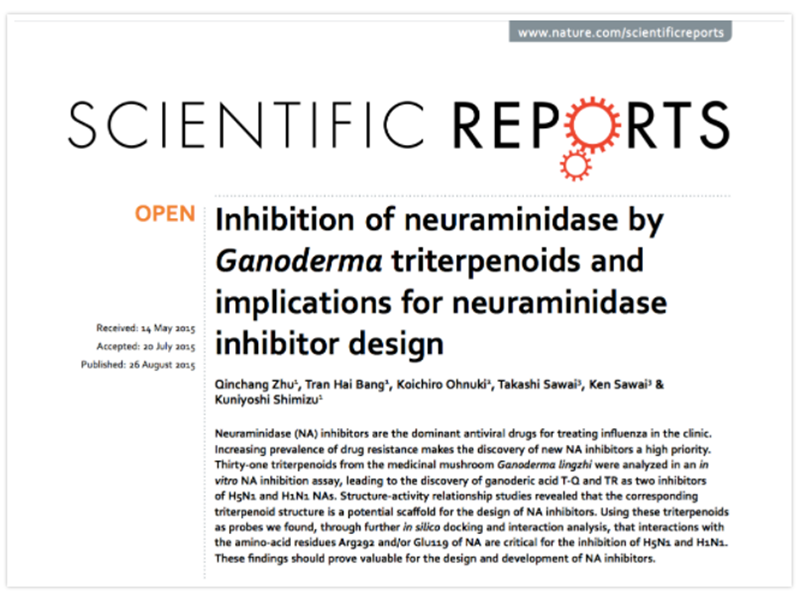Август 26, 2015 / Университет Кюсю / Научные отчеты
Текст/У Тинъяо

Исследовательская группа Куниеси Симидзу, доцент Института сельскохозяйственных наук Университета Кюсю в Японии, подтвердил, что 31 тритерпеноиды, выделенные из плодового тела ганодермы, в разной степени ингибируют нейраминидазу пяти вирусов гриппа А., среди которых есть два тритерпеноида, пригодных даже для разработки в качестве противогриппозных препаратов.. Результаты исследования были опубликованы в журнале «Научные доклады» издательской группы «Природа» в конце августа. 2015.
Нейраминидаза — один из двух белков, выступающих на поверхности вирусов гриппа А.. Каждый вирус гриппа содержит около ста таких протеаз.. Когда вирус проникает в клетку и использует материал клетки для репликации новых вирусных частиц., нейраминидаза необходима для того, чтобы новые вирусные частицы отрывались от клетки и далее инфицировали другие клетки.. Поэтому, когда нейраминидаза теряет свою активность, новый вирус будет заперт в клетке и не сможет выбраться наружу, угроза для хоста будет уменьшена, и болезнь можно контролировать. Часто используемый осельтамивир (Tamiflu) в клинической практике является использование этого принципа для предотвращения пролиферации и распространения вируса..
По данным исследования Куниеси Симидзу., в концентрации 200 мкМ, эти тритерпеноиды Ganoderma ингибировали активность H1N1., H5N1, H7N9 и два устойчивых мутантных штамма NA (H1N1, N295S) и NA (H3N2, Е119В) в разной степени. В целом, ингибирующее действие на нейраминидазу типа N1 (особенно H5N1) лучший, а ингибирующее действие на нейраминидазу H7N9 наихудшее.. Среди этих тритерпеноидов, ганодеровая кислота TQ и ганодеровая кислота TR показали самые высокие уровни ингибирования, и эффекты этих двух соединений варьировались от 55.4% к 96.5% ингибирование различных подтипов NA.
Дальнейший анализ взаимосвязи структура-активность этих тритерпеноидов показал, что тритерпеноиды, которые оказывают лучшее ингибирующее действие на нейраминидазу N1, имеют основную структуру «тетрациклических тритерпеноидов с двумя двойными связями»., ветвь в виде карбоксильной группы, и кислородсодержащая группа в сайте R5» (Магистраль А на рисунке ниже). Если основной структурой являются две другие (Магистрали B и C на рисунке ниже), эффект будет плохой.

(Источник/научный представитель. 2015 август 26;5:13194.)
In silico стыковка используется для моделирования взаимодействия ганодеровых кислот. (T-Q и TR) и нейраминидазы (H1N1 и H5N1). Как результат, было обнаружено, что и ганодеровая кислота, и Тамифлю способны напрямую связываться с активной областью нейраминидазы.. Эта активная область состоит из нескольких аминокислотных остатков.. Кислоты ганодермы TQ и TR связываются с двумя аминокислотными остатками Arg292 и Glu119.. У Тамифлю есть еще один вариант, но он также может сделать нейраминидазу неэффективной..
По сравнению с ингибированием других белков вируса гриппа (например, белок М2, который открывает оболочку вируса в момент связывания вируса с клеткой-хозяином и отправляет вирусные гены в клетку), Ингибиторы нейраминидазы в настоящее время признаны эффективными и менее резистентными препаратами для лечения гриппа.. Поэтому, исследователи полагают, что ганодеровые кислоты T-Q и TR, которые похожи, но не идентичны по механизму действия Тамифлю, имеют возможность использования в качестве противогриппозных препаратов нового поколения или эталонных образцов.
However, существует предпосылка для использования препарата в качестве противогриппозного средства., то есть, препарат должен эффективно подавлять размножение вируса, не нанося вреда инфицированным вирусом клеткам. However, в экспериментах на клетках, инфицированных живыми вирусами и линиях клеток рака молочной железы (МЦФ-7), было обнаружено, что когда исследователи использовали только эти два типа ганодеровых кислот, у них были сомнения в высокой цитотоксичности, но они также нашли еще один вид тритерпеноида ганодермы., ганодерол Б, оказывает ингибирующее действие на H5N1 (но ингибирующий эффект слабый), но он не цитотоксичен. Поэтому, Исследователи полагают, что необходимо тщательно рассмотреть вопрос о том, как повысить безопасность ганодеровых кислот T-Q и TR за счет модификации химической структуры, сохраняя при этом ингибирование активности нейраминидазы..
[Источник] Чжу Ц, и др.. Ингибирование нейраминидазы тритерпеноидами ганодермы и значение для разработки ингибиторов нейраминидазы. научный представитель. 2015 август 26;5:13194. дои: 10.1038/srep13194.
КОНЕЦ
Об авторе/ г-жа. У Тинъяо
У Тинъяо сообщает информацию из первых рук о Ганодерма с тех пор. 1999. Она является автором Лечение с помощью Ганодерма (опубликовано в Народном медицинском издательстве в апреле 2017).
★ Статья публикуется с исключительного разрешения автора..
★ Воспроизведение вышеуказанных работ не допускается., извлечены или использованы иным образом без разрешения автора.
★ За нарушение вышеуказанного заявления, автор будет нести соответствующую юридическую ответственность.
★ Оригинальный текст этой статьи был написан на китайском языке У Тинъяо и переведен на английский Альфредом Лю.. Если есть расхождения в переводе (Английский) и оригинал (китайский), оригинальный китайский будет иметь преимущественную силу. Если у читателей возникнут вопросы, пожалуйста, свяжитесь с первоначальным автором, РС. У Тинъяо.



